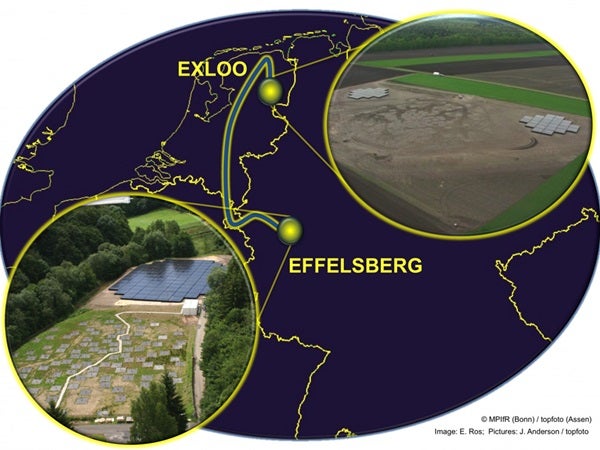An international group of astronomers have succeeded in the first joint observations between the LOFAR stations in The Netherlands and Germany. This constitutes the “first light” of the LOFAR telescope as an international array. The bright quasar 3C 196, located almost 10 billion light-years away from Earth, was detected successfully August 20, 2009, providing first “interferometric fringes,” equivalent to the “first light” for an ordinary telescope.
Olaf Wucknitz, astronomer at the Argelander-Institut for Astronomy at the University of Bonn, found conclusive proof of the detection after initial analysis of the data by astronomers from ASTRON in The Netherlands, the University of Manchester in the United Kingdom, and the Max-Planck-Institut for Radioastronomie (MPIfR) in Bonn. “Our results demonstrate the ability of LOFAR to work with stations widely separated across different countries,” Wucknitz said.
“Our colleagues in Bonn have shown that these joint observations, where different LOFAR stations spread over hundreds of kilometers are used, are not only a dream anymore but a practical reality,” said Michael Garrett, general director at ASTRON. “A completely new window on the universe beckons to us — we may not falter — the potential for scientific discovery is unprecedented.” “The LOFAR telescope station in Effelsberg and other international stations will make important contributions to the scientific success of LOFAR, and serve as a major step towards realizing a high-resolution pathfinder for future telescopes such as the Square Kilometer Array,” said Anton Zensus from MPIfR.
“I’m very proud that we have now proven all of the different LOFAR elements fit together, even across borders,” said André Gunst, leader of the LOFAR technical team at ASTRON.
“These first fringes between the Effelsberg and Dutch stations represent not only the first step towards a fantastic new telescope, but are also the result of a very fruitful European collaboration between partners from various research institutes and universities,” said Michael Kramer from MPIfr. “The MPIfR is proud to be a partner, and we look forward to the first scientific results!”
For James Anderson, station manager of the Effelsberg LOFAR station, this day has been a long time coming. “The first fringe detection by Effelsberg and Exloo is a major milestone in the European LOFAR project”.










